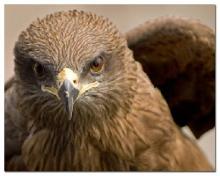The black kite is a bird of prey that searches for food from the sky, and after it swiftly snatches its prey from the ground with its claws, it immediately returns to the sky. The black kite makes use of updrafts to soar through the skies and does not really flap its wings. The black kite looks calm and leisurely when flying. The black kite is slightly larger than a crow, but the secret to its majestic air lies not only in the size of its body. Compared with crows, the black kite has superior vision. As a result, it has no need to walk along roads looking for food as crows do. It has been discovered that the eye of the black kite has a unique structure protecting it from strong ultraviolet rays, which means their eyes essentially function as sunglasses. The black kite’s eyes have an extremely strange structure called pectin, which has a branching, dendritic form. Imagine that a pattern like a hairbrush is drawn across the surface of the eye to protect it. Of course, our human eyes do not have such a structure. The pectin regulates the amount of ultraviolet rays entering into the eye and reduces the amount of bright light that the black kite feels. Thanks to the existence of the pectin in its eyes, the black kite boasts superior vision that helps it discover prey even while flying high in the sky.
- Defense/Stability:
- Light resistance、Light control
When ultraviolet rays enter through the eyes, there is an increase in the production of melanin in the body. If we developed a new type of contact lens modeled after the structure of the black kite’s eyes, it would be possible to prevent sunburns. In the medical field, we would be able to anticipate the prevention of skin cancer and cataracts, which mainly occur because of ultraviolet rays. Solutions modeled after the black kite’s eyes could be used as new anti-ultraviolet measures in our daily lives. For example, instead of sunglasses, we would be able to develop a new type of eyeglasses more capable of protecting eyes from ultraviolet rays. It would also be possible to reduce the brightness felt from direct sunlight. These applications would be very convenient for people who work and live under strong ultraviolet rays, such as when fishing or swimming in the sea. Also, if this new technology were applied to window glass, it would be possible to protect ourselves from ultraviolet rays without reducing the quality of the field of vision.


















